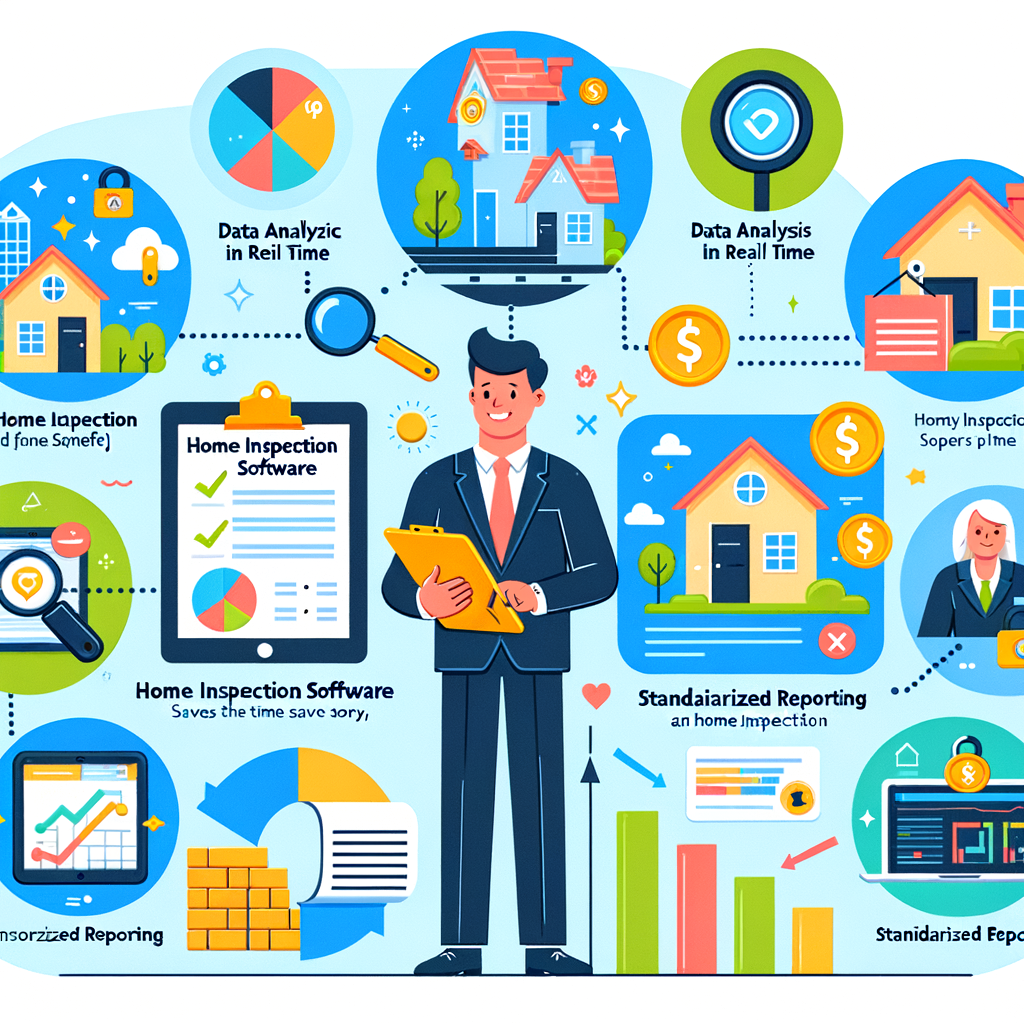Maximize Efficiency and Accuracy with Home Inspection Software Integration.
Home inspection software integration offers numerous benefits to both home inspectors and their clients. By seamlessly incorporating advanced technology into the inspection process, this integration enhances efficiency, accuracy, and overall productivity. It allows for easier data collection, analysis, and reporting, ultimately leading to improved customer satisfaction and better-informed decision-making when it comes to buying or selling a property.

Streamlining Home Inspection Processes with Software Integration
In today’s fast-paced world, efficiency is key. This holds true for all industries, including the home inspection industry. With technology advancing at a rapid pace, it has become increasingly important for home inspectors to embrace software integration in order to streamline their processes and improve overall productivity.
One of the main benefits of integrating home inspection software into the inspection process is improved accuracy. Traditional paper-based systems are prone to human error, which can result in inaccurate data being recorded or important information being missed altogether. By utilizing software specifically designed for home inspections, inspectors can reduce errors by automating various aspects of the process.
Another advantage of integrating software into home inspections is time savings. Manual data entry can be a time-consuming task that takes away from valuable time spent on actual inspections. With software integration, inspectors can eliminate this tedious task by automatically populating fields with pre-set templates or syncing data across multiple devices in real-time.
Additionally, incorporating software into the inspection process allows for better organization and record keeping. Digital files are easily searchable and can be accessed from anywhere with an internet connection, making it simple to retrieve past reports or share them with clients. Furthermore, many home inspection software solutions offer features such as photo documentation and annotation tools that help keep all relevant information in one place.
Furthermore, using specialized software enables inspectors to create professional-looking reports quickly and efficiently. Many programs offer customizable report templates that allow inspectors to brand their reports with logos and contact information while also ensuring consistency across all documents produced by the company.
Moreover, some advanced home inspection software includes features like scheduling tools that enable easy appointment management and reminders for upcoming inspections. This ensures that appointments are never missed or double-booked due to human error or oversight.
Another benefit worth mentioning is cost reduction associated with implementing digital solutions over traditional paper-based methods. By eliminating physical storage space requirements and reducing printing costs associated with generating hard copies of reports or other documents, home inspectors can save money in the long run. Additionally, digital reports are more environmentally friendly, aligning with current trends towards sustainability.
Finally, integrating software into the inspection process allows for better customer service. Many home inspection software solutions offer features like client portals or email notifications that keep clients informed about the progress of their inspections. This not only provides transparency but also enhances communication and overall customer satisfaction.
conclusion
embracing home inspection software integration offers numerous benefits to inspectors and clients alike. Improved accuracy, time savings, enhanced organization and record-keeping capabilities, professional-looking reports, advanced scheduling tools, cost reduction potential, environmental friendliness and improved customer service are just some of the advantages provided by this technological advancement.
As technology continues to evolve at an unprecedented pace, it is crucial for home inspectors to adapt by incorporating software solutions into their workflow in order to stay competitive in today’s market.
Maximizing Efficiency and Accuracy in Home Inspections through Software Integration
Home inspections play a crucial role in the real estate industry, providing potential buyers with an assessment of a property’s condition and identifying any potential issues. In recent years, there has been a significant shift towards using home inspection software to streamline and enhance this process. The integration of software into home inspections offers numerous benefits that maximize efficiency and accuracy.

One key advantage of software integration is the ability to automate various tasks involved in the inspection process. Traditionally, inspectors had to manually document their findings on paper or rely on handwritten notes. This method was not only time-consuming but also prone to errors. However, with the use of home inspection software, inspectors can easily input data directly into a digital platform using mobile devices such as tablets or smartphones.
The automation feature eliminates the need for manual transcription and ensures that information is accurately recorded in real-time during the inspection itself. This not only saves valuable time but also reduces the chances of human error when transferring data from paper to computer systems after the inspection.
Additionally, integrating software into home inspections enables seamless communication between all parties involved in the process – including inspectors, agents, and clients. Through cloud-based platforms or dedicated apps, everyone can access relevant information instantaneously at any time and from anywhere.
This level of accessibility facilitates collaboration and transparency throughout each stage of the inspection procedure. Real-time updates allow agents to quickly address any concerns raised by clients or coordinate repairs with sellers before closing deals promptly.
Moreover, another benefit offered by integrated home inspection software is its capacity for generating comprehensive reports effortlessly. These reports typically include detailed descriptions of findings along with accompanying photographs documenting specific areas or issues identified during an inspection.
By automating report generation through pre-built templates customized specifically for different types of properties (e.g., residential houses versus commercial buildings), inspectors can significantly reduce their administrative workload while ensuring consistency across all inspections they perform.
Furthermore, these digital reports are easily shareable electronically through email or secure online portals—eliminating the need for printing, scanning, or physically delivering paper copies. This not only saves costs associated with paper and ink but also contributes to a more eco-friendly approach by reducing unnecessary waste.
conclusion
the integration of home inspection software offers numerous advantages in maximizing efficiency and accuracy. The automation feature eliminates time-consuming manual tasks while minimizing potential errors during data transfer. Seamless communication through digital platforms enhances collaboration among all parties involved in the inspection process. Additionally, easy report generation ensures comprehensive documentation of findings while reducing administrative workload and promoting sustainability.
Adopting home inspection software can undoubtedly revolutionize traditional inspection practices within the real estate industry. By embracing technological advancements, inspectors can enhance their productivity and provide clients with more accurate assessments efficiently – ultimately contributing to a streamlined experience for all stakeholders involved.
Enhancing Communication and Collaboration with Home Inspection Software Integration
Home inspection is an essential process for homeowners, potential buyers, and real estate professionals. It helps identify any structural or functional issues that may exist in a property, ensuring that it meets safety standards and providing peace of mind to all parties involved. In recent years, the integration of home inspection software has revolutionized this industry by streamlining processes and improving communication between inspectors, clients, and other stakeholders.

One of the key benefits of integrating home inspection software is enhanced communication. Traditionally, home inspections involved lengthy paper reports that were prone to errors and could be difficult to interpret. With software integration, inspectors can now create comprehensive digital reports that are not only easier to understand but also include detailed photographs and videos as evidence.
By using interactive features such as annotations or markups within the software, inspectors can easily highlight areas of concern directly on photos or floor plans. This visual representation allows clients to grasp the severity of an issue more effectively than mere text descriptions. Moreover, these digital reports can be instantly shared via email or uploaded onto a cloud-based platform accessible from any device with internet connectivity.
In addition to improved communication through digital reporting capabilities, home inspection software integration also facilitates collaboration among different stakeholders involved in the inspection process. For instance, when a potential buyer hires a home inspector before purchasing a property, they often seek advice from various experts such as electricians or plumbers for further evaluation on specific aspects like electrical systems or plumbing infrastructure.
With integrated software platforms that support multi-user access privileges in real-time mode – including comment sections for discussions – collaboration becomes seamless. Allowing each stakeholder access to relevant information ensures everyone is on the same page throughout the process while eliminating time-consuming back-and-forth communications.
Furthermore; this collaborative approach extends beyond just immediate participants; even remote individuals like sellers who cannot physically attend inspections can benefit from online access granting them transparency into the findings through notes provided by inspectors. By fostering open communication and enabling collaboration among all involved parties, home inspection software integration ensures that everyone remains informed, making more informed decisions when it comes to property transactions.
Another advantage of software integration in the home inspection industry is the ability to streamline administrative tasks and automate processes. This includes automating appointment scheduling, sending reminders or notifications to clients, generating invoices or receipts, and managing client data securely.
By reducing manual paperwork and eliminating repetitive tasks through automation features, inspectors can focus on their core responsibilities – conducting thorough inspections and providing high-quality reports – resulting in increased efficiency and productivity. Furthermore; storing client information electronically ensures easy retrieval for future reference or follow-up purposes.
Overall; the benefits of integrating home inspection software are numerous. Enhanced communication through digital reporting allows for better understanding of issues identified during inspections; collaboration among stakeholders promotes transparency while saving time with real-time access privileges; automation streamlines administrative tasks increasing efficiency overall.
As technology continues to evolve within the field of home inspections, embracing such advancements becomes imperative for professionals aiming to provide outstanding service quality while optimizing their operations in this ever-changing landscape. Home inspection software integration not only enhances communication but also enables effective collaboration while streamlining administrative processes – undoubtedly offering a competitive edge within the industry
Improving Reporting and Documentation in Home Inspections using Integrated Software Solutions

Home inspections play a crucial role in the real estate industry. Whether it is for buyers or sellers, conducting a thorough inspection of a property is essential to ensure transparency and identify any potential issues before closing a deal. With advancements in technology, home inspection software integration has emerged as an effective tool to streamline the reporting and documentation process.
One of the key benefits of integrating home inspection software into the process is improved efficiency in generating reports. Traditionally, inspectors would manually compile their findings into lengthy and time-consuming written reports. However, with integrated software solutions, inspectors can now input data directly into digital templates tailored specifically for home inspections. This not only saves time but also reduces human error by eliminating the need for manual transcription.
Furthermore, home inspection software offers standardized reporting formats that enhance clarity and consistency across different inspections. These digital templates often include predefined categories covering all areas of concern such as electrical systems, plumbing fixtures, roofing materials, and structural components. By following these predetermined categories during inspections using the integrated software solution, inspectors can ensure comprehensive coverage without overlooking any critical details.
In addition to efficient report generation and standardization, integrating home inspection software provides features that facilitate multimedia documentation capabilities. Inspectors can capture photos or videos on-site using mobile devices such as smartphones or tablets and directly embed them within their reports through the integrated software solution. This not only enhances visual representation but also adds another layer of credibility to support observations made during inspections.
Moreover, by incorporating cloud-based storage systems within these integrated solutions, all gathered data including photos/videos are securely stored online rather than relying on physical copies that can be easily misplaced or damaged over time. The accessibility offered by cloud storage ensures easy retrieval whenever necessary throughout various stages of real estate transactions or even future reference purposes.
Another advantage derived from implementing integrated home inspection software lies in its ability to generate accurate cost estimates for repairs or renovations needed based on identified issues during inspections. Once specific concerns are documented digitally within the software, it can automatically generate estimated costs by considering prevailing market rates for materials and labor.
This not only benefits both buyers and sellers in negotiating appropriate pricing but also provides a comprehensive understanding of potential financial implications associated with property maintenance or improvements.
Additionally, integrated home inspection software enables easy collaboration between different parties involved in real estate transactions. Through cloud-based platforms, various stakeholders such as agents, clients, inspectors, and contractors can access reports simultaneously and engage in discussions through comment sections or messaging features within the integrated software solution itself. This fosters efficient communication, eliminates misunderstandings arising from lengthy email threads or phone calls, and expedites decision-making processes during negotiations.
conclusion
integrating home inspection software into the reporting and documentation process offers numerous benefits that enhance efficiency and transparency within the real estate industry. From streamlining report generation to standardized formats to multimedia documentation capabilities to accurate cost estimation for repairs – these integrated solutions have revolutionized the way home inspections are conducted.
Moreover, they enable seamless collaboration among all parties involved while ensuring secure data storage through cloud-based systems. As technology continues to evolve further in this field, it is evident that embracing these advancements will continue to improve the overall effectiveness of home inspections going forward.
Increasing Productivity and Time Savings with Home Inspection Software Integration
Home inspection is a crucial aspect of the real estate industry, providing buyers and sellers with valuable insights into the condition of a property. As technology continues to evolve, home inspectors are now able to leverage software solutions that can greatly enhance their productivity and save them time. Integrating home inspection software into their workflow offers numerous benefits, from streamlining processes to improving accuracy and efficiency.

One significant advantage of integrating home inspection software is the ability to create digital reports quickly and effortlessly. In the past, home inspectors had to rely on handwritten notes or manual data entry, which could be time-consuming and prone to errors. With software integration, however, inspectors can input information directly into an electronic form during the inspection process itself. This eliminates the need for double entry later on and reduces transcription errors significantly.
Furthermore, these integrated software solutions often come equipped with templates that follow standardized reporting formats commonly used in the industry. This not only saves time but also ensures consistency across different inspections conducted by various inspectors within a company. Such uniformity enhances professionalism and instills confidence in clients who rely on accurate reports when making important decisions regarding property purchases.
Another major advantage of integrating home inspection software is its ability to streamline communication between all parties involved in a transaction. Traditionally, after completing an inspection, inspectors would have to compile their findings manually and send them via email or other means of communication. However, with integrated software solutions that offer cloud-based storage capabilities, reports can be uploaded instantly and shared with relevant stakeholders immediately upon completion.
This real-time access allows agents or clients involved in a transaction to view reports promptly without having to wait for physical copies or extensive back-and-forth email exchanges. Additionally, some software platforms even provide interactive features such as adding annotations or comments directly onto specific sections of the report for easier collaboration between all parties involved.
In addition to enhancing communication efficiency, integrating home inspection software also facilitates better scheduling management for both inspectors and clients alike. These software solutions often come equipped with calendar and scheduling features that allow inspectors to manage their appointments more effectively. This helps prevent overbooking or missed inspections, ensuring a smooth workflow and avoiding any potential delays or inconveniences for clients.
Moreover, some home inspection software platforms also offer the ability to generate automated reminders for upcoming appointments, eliminating the risk of forgetting important tasks or deadlines. These reminders can be sent via email or even SMS notifications, providing inspectors with an additional layer of organization and ensuring all parties are well-prepared when it comes time for inspections.
Overall, integrating home inspection software into the workflow of real estate professionals offers significant benefits in terms of increasing productivity and saving time.
The ability to create digital reports quickly and effortlessly, streamline communication between stakeholders, as well as facilitate better scheduling management are just a few examples of how these integrated solutions can transform the way inspections are conducted. As technology continues to advance, it is becoming increasingly clear that embracing such innovations is essential in maintaining competitiveness within the real estate industry.
Empowering Real Estate Professionals with Integrated Home Inspection Tools
In today’s rapidly evolving real estate industry, staying ahead of the competition is crucial for professionals in the field. With advances in technology, integrating home inspection software has become a game-changer for real estate professionals. This article will explore the benefits of incorporating home inspection software into their workflow.

First and foremost, one of the significant advantages of integrating home inspection software is increased efficiency. Traditional methods of conducting inspections involved cumbersome paperwork and time-consuming processes. However, with the integration of specialized software, professionals can streamline their operations by digitizing documents and automating various tasks. This not only saves time but also reduces errors that may occur during manual data entry.
Furthermore, home inspection software allows for seamless collaboration between different stakeholders involved in the buying or selling process. Realtors can easily share reports with clients and other interested parties such as lenders or insurance providers through cloud-based platforms. This ensures that all relevant information is accessible to everyone involved at any given time, leading to better-informed decision-making.
Additionally, integrated home inspection tools offer advanced features that enhance accuracy and reliability. These tools often include built-in checklists and templates specific to various property types and structural elements. By utilizing these resources, real estate professionals can ensure comprehensive inspections are conducted consistently across properties while adhering to industry standards.
Another significant benefit of incorporating home inspection software is improved customer satisfaction. Clients expect a smooth and transparent buying experience when working with real estate professionals. By leveraging digital solutions like photo documentation capabilities offered by such software programs, agents can provide visual evidence along with detailed reports on property conditions directly to clients’ devices or via email communication channels promptly.
Moreover, integrated home inspection tools enable efficient report generation by automatically populating relevant data from inspections into standardized templates tailored to meet regulatory requirements or specific client preferences. This eliminates tedious manual report creation processes while ensuring consistency in reporting quality throughout an agent’s portfolio.
Additionally, integrated home inspection software provides valuable analytics capabilities that empower professionals in making informed decisions. By aggregating data from multiple inspections, real estate professionals can identify trends, patterns, and areas of improvement within their operations. These insights enable them to optimize processes and refine strategies to better meet the needs of their clients.
Lastly, integrating home inspection software supports sustainability efforts in the industry. Digitizing paper-based documentation reduces waste and minimizes carbon footprints associated with printing and storing physical files. Furthermore, by conducting inspections digitally, professionals can eliminate travel-related emissions by utilizing remote inspection options whenever possible.
conclusion
integrating home inspection software into the workflow of real estate professionals offers numerous benefits that enhance efficiency, collaboration, accuracy, customer satisfaction, decision-making capabilities and support sustainability initiatives.
As technology continues to advance rapidly within the industry, those who embrace these integrated tools will be at a significant advantage over their competitors. It is evident that incorporating home inspection software has become an essential component for empowering real estate professionals in today’s evolving market landscape.
Leveraging Technology for Better Decision-Making in Home Inspections through Software Integration
Home inspections are a critical part of the real estate industry, providing potential buyers with valuable insights into the condition of a property before making a purchase. Traditionally, home inspectors relied on manual methods and paper-based reports to document their findings. However, with advancements in technology, software integration has emerged as an invaluable tool in streamlining the home inspection process.

One of the key benefits of integrating software into home inspections is improved efficiency. In the past, inspectors had to manually input data collected during an inspection into their reports, often leading to errors or omissions.
By utilizing dedicated home inspection software, inspectors can now input data directly into digital templates on mobile devices or laptops while conducting inspections onsite. This eliminates the need for double entry and ensures that all relevant information is captured accurately and efficiently.
In addition to increased efficiency, software integration also enhances the quality and consistency of home inspection reports. With pre-built templates and standardized checklists available within these programs, inspectors can ensure that no aspect of a property goes unnoticed during an assessment. This not only provides peace of mind to potential buyers but also protects both parties from any legal disputes arising from missed defects or discrepancies.
Furthermore, integrating software into home inspections allows for seamless collaboration between various stakeholders involved in real estate transactions. Realtors can access inspection reports instantly online, enabling them to address any issues promptly with sellers or negotiate repairs as necessary before closing deals. Mortgage lenders can also review detailed reports quickly when processing loan applications based on accurate assessments provided by professional inspectors.
Moreover, integrating technology into home inspections enables efficient management and organization of large volumes of data gathered during each assessment. Inspection photos can be easily uploaded onto cloud-based platforms directly from mobile devices; this not only saves storage space but also ensures that visual evidence is readily accessible whenever needed – even years after an initial report was filed.
Another significant advantage offered by software integration is the ability to generate comprehensive and visually appealing reports. These programs often come equipped with customizable features that allow inspectors to incorporate photos, diagrams, and annotations into their reports. This not only enhances the overall presentation of findings but also provides buyers with a clear understanding of any potential issues or recommended repairs.
Moreover, software integration offers opportunities for data analysis and trend tracking over time. By aggregating information from multiple inspections, patterns can be identified that may indicate common problems in specific types of properties or regions. This valuable insight allows industry professionals to better understand emerging trends and make informed decisions regarding property investments.
However, it is important to note that while software integration undoubtedly provides numerous benefits for home inspections, it should never replace the expertise and experience of professional inspectors. Software should be viewed as a tool to augment their abilities rather than a substitute for their knowledge.
conclusion
leveraging technology through software integration has revolutionized the home inspection process by increasing efficiency, improving report quality and consistency, facilitating collaboration between stakeholders, simplifying data management, enhancing report presentation, enabling data analysis and trend tracking.
As technology continues to advance rapidly within various industries including real estate – it is crucial for professionals involved in home inspections to embrace these tools in order to adapt and remain competitive in an ever-evolving market landscapeIn conclusion, the integration of home inspection software provides numerous benefits for professionals in the industry.
It streamlines and automates the inspection process, improving efficiency and accuracy. The software enables easy data collection and organization, reducing paperwork and manual errors. Additionally, it facilitates seamless communication between inspectors, clients, and other stakeholders involved in the home inspection process. Overall, integrating home inspection software enhances productivity, professionalism, and customer satisfaction in this field.
